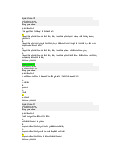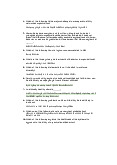





Preview text:
ĐỀ KIỂM TRA CUỐI KỲ
HỌC KỲ 1 NĂM HỌC 2022 - 2023
TÊN MÔN THI : BUSINESS MEETING & NEGOTIATION SKILL MSMH
: ANH420DE01 Có câu hỏi trắc nghiệm
Thời lượng thi : 90 phút (không kể thời gian phát đề)
Không được tham khảo tài liệu
Sinh viên làm vào Phiếu trả lời
Họ và tên: ..………………………………….………… Giám thị 1: Giám thị 2:
MSSV:……..…………………………………………..
Ngày thi: ………………………………………………
Điểm tổng kết (thang 10) Nhận xét Giảng viên chấm thi Điểm bằng số
Điểm bằng chữ (áp dụng cho kiểm tra cuối kỳ) TOTAL: I. Multiple choice (60 pts)
Concepts, terms, principles of negotiation (30 marks)
1. Negotiation is best described as:
A. a contest of wills between opposing parties
B. an interpersonal decision-making process necessary whenever people cannot achieve their objectives single-handedly C. a third-party mediation
D. the process of compromise so as to instigate conflict with one side coming out the victor
2. Successful negotiators should concern themselves with
A. what is happening throughout the world
B. what is happening in their major industry throughout the world
C. what is happening in the local market
D. none of the above statements
3. Being a successful negotiator depends on:
A. “outsmarting” the counterparty
B. the counterparty’s lack of preparation
C. experiential learning, feedback, and learning new skills
D. always letting the other party tip their hand first
4. One of the major shortcomings in negotiation occurs when negotiators make an offer that is too generous and
is immediately accepted by the counterparty. This negotiation trap is called: A. egocentrism C. the winner’s curse B. the confirmation bias
D. the mixed-motive negotiator
5. The tendency for people to view their decision making and negotiation abilities in a way that is flattering or
fulfilling for them is known as: A. focal points
B. self-reinforcing confidence C. reactive devaluation D. egocentrism 1/6
6. One of the common mistakes negotiators often make is
A. setting for terms that are worse than their best alternative.
B. being so aggressive that they always want to be the ones who initiate the argument.
C. learning to much about other parties in the negotiation
D. trying to reach satisfaction for all participants in the negotiation
7. A type of negotiation behavior known as reactive devaluation refers to:
A. a negotiator who does not know what he or she really wants other than not wanting what the other party is offering
B. a negotiator who sets the target point too high and refuses to make any concessions
C. a negotiator who overvalues the counterparty’s offer
D. an negotiator who opens the negotiation by setting their target too low
8. A negotiator’s BATNA (Best Alternative to a Negotiated Agreement) determines the point at which a negotiator is prepared to: A. make larger concessions B. keep options open
C. walk away from the negotiation table
D. identify the counterparty’s alternatives
9. One strategy for improving one’s BATNA in negotiation is to:
A. discuss it in explicit terms with the counterparty
B. improve your alternative options before going to the negotiation table
C. replace it with an aspiration point
D. revise it in reaction to progress of the negotiation
10. In negotiation, buyers and sellers may adopt differing bargaining positions for an object, but their private
valuations for the object should not differ as a consequence of who has possession. The endowment effect is best described as:
A. the difference between what seller’s demand and what buyers are willing to pay
B. a tendency for people to value an object more once they own it
C. the intrinsic value we associate with a certain outcome
D. saving money instead of purchasing goods
11. In negotiation which of the following statements is generally not true when it comes to a negotiator’s BATNA?
A. It is dynamic and constantly changing
B. It is generally wise to reveal it
C. It is determined by the negotiator’s available options
D. It influences a negotiator’s reservation price
12. In negotiation, the fixed-pie perception is defined as:
A. the assumption that attacking the other party is the best way to get most of the pie
B. the assumption that capitulating to the other negotiating party’s demands is the best way to a win-win agreement
C. the belief that concessions are necessary by one or both parties in order to reach an agreement
D. the assumption that sticking to your demands and refusing anything but the majority of the pie is the
best way to get most of the pie
13. Negotiation is best described as a _______, which involves both _________ and ________.
A. self-assessment; focus; introspection
B. grass-is-greener negotiation; selectiveness; restlessness
C. strategic risk; aggressiveness; gambling
D. mixed-motive enterprise; cooperation; competition 2/6
14. Negotiators should assess themselves and their resources before commencing negotiation. One question a
negotiator should ask is, “What are my sunk costs?” A sunk cost is best defined as:
A. money you have invested, that is for all practical purposes, spent B. a contractual cost
C. money you expect to be paid at the completion of a service contract
D. the yield expected from a stock price
15. Negotiators should take the time to brainstorm how a single-issue negotiation may be segmented into multiple
issues. By identifying and segmenting the negotiation into multiple issues, negotiators may create ________.
A. a less complicated negotiation
B. more issues that could lead to an impasse C. integrative potential
D. a potentially illegal negotiation situation
16. What is meant by the hidden table in a negotiation?
A. An undisclosed group of resources
B. The ultimate goal of a good negotiator
C. Important parties who are the real decision makers are not present at the negotiation table
D. The undisclosed offers that could have been made
17. The bargaining zone, or zone of possible agreements (ZOPA), is the range:
A. below the seller’s reservation point and above the buyer’s target point
B. above the seller’s focal point and above the buyer’s aspiration point
C. between negotiators’ reservation points
D. between negotiators’ target points
18. The negotiator’s surplus is the positive difference between:
A. negotiators’ reservation points
B. the settlement outcome and the negotiator’s reservation point
C. the bargaining surplus and the settlement outcome
D. the best and worst possible economic outcomes
19. If you reveal your reservation point during the course of negotiation:
A. the other party has little or no incentive to offer you more
B. parties will reach an impasse
C. the counterparty will reveal his or her reservation point
D. you will get a bigger slice of the pie
20. A negative bargaining zone indicates that:
A. parties are worse off by not reaching agreement than by reaching agreement
B. there is no positive overlap between the parties’ reservation points
C. parties should keep negotiating to find a positive bargaining zone
D. the counterparty’s first offer was not accepted
21. Because negotiations are costly to prolong, it is in both parties’ interests to determine whether a positive
bargaining zone is possible. If the negotiators discover that no positive bargaining zone exists, what is the
recommended action they should take? A. Continue negotiating
B. Stop negotiations and pursue other alternatives
C. Increase the group size of both negotiating parties D. Take a break
22. The _______ is a measure of the value that a negotiated agreement offers to both parties over the value of not reaching a settlement. A. negotiator’s surplus B. bargaining surplus 3/6 C. BATNA D. target point
23. Negotiators who desire to increase their share of the bargaining zone are best advised to: A. set fair aspirations
B. reveal their reservation price C. improve their BATNA
D. avoid making the first offer
24. Revealing information about a BATNA or a reservation point:
A. reduces a negotiator’s power in a negotiation
B. increases the counterparty’s propensity for strategic risk taking
C. is a pie-expanding strategy
D. improves the negotiator’s odds of getting what they want
25. When both parties to negotiation have the same interests, but fail to capitalize on compatible interests, this situation is best termed: A. naive conflict B. the lose-lose effect C. premature concessions D. the propinquity effects
26. Regarding the interests, rights and power model of disputing, a negotiator who uses a power-based approach is characterized by:
A. an interest in reconciling differences in a way that addresses the counterparty’s most pressing needs and concerns
B. a need to apply standards of fairness to negotiation
C. an interest in formalizing parties’ rights by law or contract
D. using status, rank, threats, and intimidation to prevail
27. Considering the psychological mechanisms for building trust between negotiators, which of the following
situations best illustrates the similarity-attraction effect?
A. A sales trainee wears shorts to the office, but the boss wears a suit
B. Marchers in a political demonstration dress in all black
C. A man strikes up a conversation with an older gentleman reading the same book as he is
D. People with diverse backgrounds generate more creative solutions
28. Power in negotiation is based on a negotiator’s perceived ability to influence others. Two types of power exist
that relate to power influence; ______ is the power people have over other people; ______ is the freedom
people have from other people’s power influence. A. social capital; status
B. perceived power; potential power
C. social power; personal power
D. realized power; social capital
29. Which of the following is an example of in-group favoritism in negotiation?
A. The belief that the members of one’s own group are better or more deserving than members of another group
B. The belief that people should only be members of a single group and avoid joint membership
C. A person works less hard when part of a group effort than they would individually
D. A person interprets their interactions with their adversaries in an altruistic way
30. When a group member contributes less effort and works less hard when working in a group as compared to
working alone, this is known as: A. social striving C. marginalization B. affiliation bias D. social loafing 4/6
Language for negotiations (30 marks)
31. Which of the following statement indicates clarifying problems in the meeting?
A. Would you like me to do it?
C. To sum up what we’ve agreed so far.
B. Can you expand upon that last point?
D. Can I draw your attention to item one?
32. Which of the following phrase indicates that the project is progressing badly?
A. We are going to make the deadline. C. The project is over budget
B. We finished the work ahead of time.
D. The project is ahead of schedule
33. Meeting chairperson: “We’ve got a lot to do today so let’s get it started. Now everyone’s here apart
from John in Facilities. But we have________from him. A. A welcome C. Minutes B. Apologies D. Items
34. Which of the following statement indicates asking for and checking information in a formal meeting?
A. Personally, I think we should…
B. Let’s wrap up what we’ve discussed today. C. Can you be more specific?
D. Thank you for being here in the meeting today
35. Which of the following expression does NOT indicates the course of dealing with recent developments?
A. Jandara, can you tell us how the XYZ project is progressing?
B. Jenjira, how is the XYZ project coming along?
C. Jampa, have you completed the report on the new accounting package?
D. Has everyone received a copy of the Siam Foundation report?
36-45. Complete a chairman’s introduction with provided words. There are two extra words. Agenda the minutes issues updated standing in Absentees any other business attending discuss apologies
Welcome to the latest meeting for the Samuel Project. I appreciate that you're all busy and thanks for
_________. My name is David Mitchell and I will be the Chair for today's meeting. Steve Crowther will be taking ___________.
You'll find a copy of the meeting _________ in front of you on the table. As you can see, there are 7 items
which we are going to ________today. I ________ the agenda this morning, so it should be fine. But if
you have any other ________ which you would like to talk about, please do it in the ______________
part of the meeting at the end.
There are two ____________ from today's meeting, Peter Jackson can't attend today due to a prior commitment.
He sends his _________. Also, Sarah Campbell can't make it, she's on holiday. So, John Hopkins is __________
for Sarah today. Does anybody have any questions?'
46-50. Read these comments by candidates in interviews. Match the personal qualities to the
comments. There are two extra words. ambitious trustworthy flexible creative passionate hard-working determined
46. My employer trusted me and let me deal with clients on my own.
47. In 4- or 5-years’ time, I’d hope to be one of the top-notch sale leaders in your company.
48. I don’t mind working overtime in case there is certain requirement from my employer.
49. I think it’s important to come up with new ideas in work.
50. I can adapt myself to different working environment. 5/6 II. Case study (40pts)
Please read the case study below and answer the questions
An advertisement has been placed on the company’s and on major recruitment’s websites for a great opportunity
to be employed as Country Manager at ABA insurance company in the UAE. ABA company expected to pay
monthly salary ranging from $12,000 to $34,000 for this position based on experience and contributions.
You read the job description and believe you are fit for this position with a desirable salary of $15,000. You want
to negotiate with the General Manager, Dr. David Smith, that you would like to excel and get promoted as
“Country Manager”, from your current position as the “Dubai’s branch manager”. This position will provide you
with many opportunities such as higher salary, more responsibilities, and utilizing more of your technical and leadership skills.
In addition, you have been working with the company since September 2015 as a full-time employee with your
monthly salary at $9,000 and have made enormous contribution to the organization. From your experience you
have also determined that Dr. Smith is “thinker” personality type as per The Myers-Briggs Type Indicator.
1. What would be your negotiation process? (10pts)
2. What will be your BATNA? (10pts)
3. Please identify and calculate your bargaining zone, settlement, and surpluses from both sides. (20pts)
_______________________________________________ THIS IS THE END OF THE TEST 6/6




